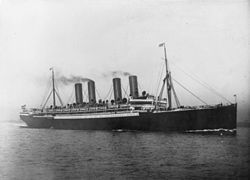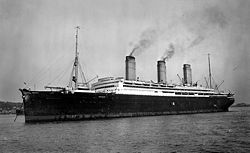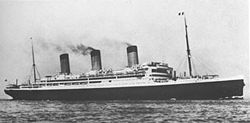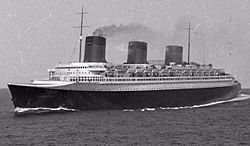Timeline of largest passenger ships
From Wikipedia, the free encyclopedia
This is a timeline of the world's largest passenger ships based upon internal volume, initially measured by gross register tonnage and later by gross tonnage. This timeline reflects the largest extant passenger ship in the world at any given time. If a given ship was superseded by another, scrapped, or lost at sea, it is then succeeded. Some records for tonnage outlived the ships that set them - notably the SS Great Eastern, and RMS Queen Elizabeth. The term "largest passenger ship" has evolved over time to also include ships by length as supertankers built by the 1970s were over 400 metres (1,300 ft) long. In the modern era the term has gradually fallen out of use in favor of "largest cruise ship" as the industry has shifted to cruising rather than transatlantic ocean travel.[1] While some of these modern cruise ships were later expanded, they did not regain their "largest" titles.
This article has multiple issues. Please help improve it or discuss these issues on the talk page. (Learn how and when to remove these messages)
|

Timeline
Summarize
Perspective
| Year completed | Ship | Tonnage | Length | Title held | Status | Image |
|---|---|---|---|---|---|---|
| 19th century | ||||||
| 1831 | SS Royal William | 1,370 GRT[2] | 49 m (160 ft) | 1831 – 1839[3] | Sank in 1860 |  |
| 1838 | SS Great Western | 1,700 GRT[4] | 76.8 m (252 ft) | 1839[5] | Scrapped in 1856 |  |
| 1839 | SS British Queen | 1,850 GRT[6] | 75 m (245 ft) | 1839 – 1840[7][8] 1841 – 1843 |
Scrapped in 1844 |  |
| 1840 | SS President | 2,366 GRT[9] | 74 m (243 ft) | 1840 – 1841[10] | Lost at sea in 1841 |  |
| 1843[a] | SS Great Britain | 3,270 GRT[11] | 98 m (322 ft) | 1843 – 1853[12] | Currently a Museum ship |  |
| 1853[13] | SS Atrato | 3,466 GRT[14] | 107 m
(350 ft) |
1853 – 1857[15][b] | Sank in 1884 |  |
| 1857 | SS Adriatic | 3,670 GRT[16] | 108 m
(354 ft) |
1857 — 1858[17] | Beached and Abandoned in 1885 |  |
| 1858 | SS Great Eastern | 18,915 GRT[18] | 211 m (692 ft) | 1858 – c. 1888[19][20] (Scrapped) |
Scrapped by 1891[c] |  |
| 1888 | SS City of New York | 10,499 GRT[23] | 171 m
(560 ft) |
c. 1888 – 1893[20] | Scrapped in 1923 |  |
| 1893 | RMS Campania RMS Lucania[d] |
12,950 GRT[24] | 190 m (622 ft) | 1893 – 1897[25] | Campania: Sank in 1918
Lucania: Scrapped in 1909 |
 |
| 1897 | SS Kaiser Wilhelm der Grosse | 14,349 GRT[26] | 200 m (655 ft) | 1897 – 1899[27] | Sank in 1914 |  |
| 1899 | RMS Oceanic | 17,272 GRT[28] | 215 m (704 ft) | 1899 – 1901[29] | Sank in 1914 |  |
| 20th century | ||||||
| 11 July 1901 | RMS Celtic | 20,904 GRT[30] | 214 m (701 ft) | 1901 – 1903[31][32] | Ran aground in 1928, Scrapped on site in 1929 |  |
| 31 January 1903 | RMS Cedric | 21,073 GRT[33] | 213 m
(700 ft) |
1903 – 1904[32] | Scrapped in 1932 |  |
| 23 June 1904 | RMS Baltic | 23,876 GRT[34] | 222 m (729 ft) | 1904 – 1906[34][35] | Scrapped in 1933 |  |
| 10 May 1906 (entered service) |
SS Kaiserin Auguste Victoria | 24,581 GRT[36] | 206.5 m (677.5 ft) | 1906 – 1907[37] | Scrapped in 1930 |  |
| 7 September 1907 (entered service) |
RMS Lusitania | 31,550 GRT[38] | 240 m (787 ft) | 1907[39][40] | Sank in 1915 |  |
| 7 November 1907 | RMS Mauretania | 31,938 GRT[38] | 241 m
(790 ft) |
1907 – 1911[40][41] | Scrapped in 1935 |  |
| 31 May 1911 | RMS Olympic | 45,324 GRT[42] | 269.0 m (882.5 ft) | 1911 – 1912[43][44] 1912 – 1913[43][45] |
Scrapped by 1937 |  |
| 31 March 1912 | RMS Titanic | 46,328 GRT[46] | 269.1 m (882.9 ft) | 1912[47] (Sank) |
Sank in 1912[47] |  |
| June 1913 | SS Imperator | 52,117 GRT[48] | 276 m (906 ft) | 1913 – 1914[45][48] | Scrapped in 1938 |  |
| 14 May 1914 (entered service) |
SS Vaterland | 54,282 GRT[49][50] | 290 m (950 ft) | 1914 – 1922[51][52] | Scrapped in 1938 |  |
| 12 May 1922 (entered service) |
RMS Majestic | 56,551 GRT[53] | 291 m (956 ft) | 1922 – 1935[52][54] | Scrapped in 1943 (after sinking) |
 |
| 29 May 1935 (entered service) |
SS Normandie | 79,280 GRT (as built) 83,404 GRT (final size)[e] |
314 m (1,029 ft) | 1935 – 1936[56] 1936 – 1942[55][57] (Destroyed by fire) |
Scrapped in 1946 (after sinking) |
 |
| 27 May 1936 (entered service) |
RMS Queen Mary | 80,774 GRT (as built) | 310.7 m (1,019.4 ft) | 1936[60][59] | Currently a Hotel ship |  |
| 2 March 1940[f] | RMS Queen Elizabeth | 83,673 GRT[61] | 314 m (1,031 ft) | 1942 – 1972[57] (Destroyed by fire) |
Scrapped in 1974 (after sinking) |
 |
| 3 February 1962 (entered service) |
SS France (1962-1980) SS Norway (post-1980) |
66,343 GRT (as built)[62] 76,049 GRT (final size)[g] |
315 m (1,035 ft) | 1972 – 1987[66][67] 1990 – 1995[68][69] |
Scrapped in 2008 |  |
| 18 December 1987 | MS Sovereign of the Seas | 73,529 GT[70] | 268 m
(880 ft) |
1987 – 1990[67][69] (Surpassed by SS Norway) |
Scrapped in 2020 |  |
| 26 June 1995 | Sun Princess | 77,000 GT[71][72] | 261 m (857 ft) | 1995 – 1996[72] | In service as Pacific World |  |
| 24 November 1996 (entered service) |
Carnival Destiny | 101,353 GT[72] | 272 m (893 ft) | 1996 – 1998[72] | In service as Carnival Sunshine |  |
| 27 May 1998 (entered service) |
Grand Princess | 109,000 GT | 290 m (951 ft) | 1998 – 1999 | In service |  |
| 29 October 1999 | Voyager of the Seas | 137,276 GT[73] | 311 m
(1,020 ft) |
1999 – 2000 | In service |  |
| 28 September 2000 | Explorer of the Seas | 137,308 GT | 311 m
(1,020 ft) |
2000 – 2002 | In service |  |
| 21st century | ||||||
| 18 November 2002 | Navigator of the Seas | 139,999 GT[74] | 311 m (1,020 ft) | 2002 – 2003 | In service |  |
| 22 December 2003 | RMS Queen Mary 2 | 148,528 GT (as built)[75] |
345.03 m (1,132.0 ft) | 2003 – 2006 | In service |  |
| 24 April 2006 | MS Freedom of the Seas | 154,407 GT (as built)[76] |
338.774 m (1,111.46 ft) | 2006 – 2007[h] | In service |  |
| 19 May 2007 | Liberty of the Seas | 155,889 GT[77] | 338.92 m (1,111.9 ft) | 2007 – 2009 | In service |  |
| 28 October 2009 | Oasis of the Seas | 225,282 GT[78] (as built) |
360 m (1,180 ft) | 2009 – 2016[i] | In service |  |
| 13 May 2016 | Harmony of the Seas | 226,963 GT[82] | 362.12 m (1,188.1 ft) | 2016 – 2018 | In service |  |
| 23 March 2018 | Symphony of the Seas | 228,081 GT[83] | 361.011 m (1,184.42 ft) | 2018 – 2022 | In service |  |
| 27 January 2022 | Wonder of the Seas | 236,857 GT[84] | 362.04 m (1,187.8 ft) | 2022 – 2023 | In service |  |
| 27 November 2023 | Icon of the Seas | 248,663 GT[85] | 364.75 m (1,196.7 ft) | 2023 – present | In service | |
See also
Notes
- While the Great Republic was concurrently larger (at 4,555 GRT), she was not a passenger ship.
- The tonnage was increased on Normandie in August 1936 to reclaim the title of "largest ship" from the Queen Mary.[55]
- Although Queen Elizabeth was completed on 2 March 1940 as an ocean liner, she was converted into a troop ship due to the outbreak of World War II. She became the largest ship in the world in 1942 when SS Normandie burned and sank at her moorings. Transatlantic service was not resumed until after the war ended, and Queen Elizabeth officially entered into passenger service on 16 October 1946.
- Oasis was initially launched at 225,282 GT.[79] This was tied a year later by Allure of the Seas, although the latter was 50 mm (2.0 in) longer.[80] Oasis of the Seas was expanded to 226,838 GT in November 2019.[81]
References
External links
Wikiwand - on
Seamless Wikipedia browsing. On steroids.
